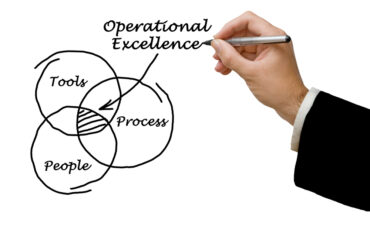
The Enterprise-In-Motion needs to encourage and promote design thinking initiatives.
Design Thinking is a relatively new approach that helps organizations innovate through empathizing with their target customers, ideate, and quickly prototype with innovative solutions. This is often followed by testing and deployment. The whole Design Thinking process is dynamic, with multiple continuous iterations between the phases. The Enterprise-In-Motion needs to encourage and promote design thinking initiatives. It implies a focus on innovation with budget, time, and resource allocations. Design Thinking engages multiple disciplines and creates a prioritized backlog of innovative solutions – balancing ease of development, optimized customer experiences, market opportunities, and business value. Design Thinking engages various innovators and allows the Enterprise-In-Motion to think big, think innovation, think digital – but start small.
A core enabler for Design Thinking is Digital Process Automation (DPA).
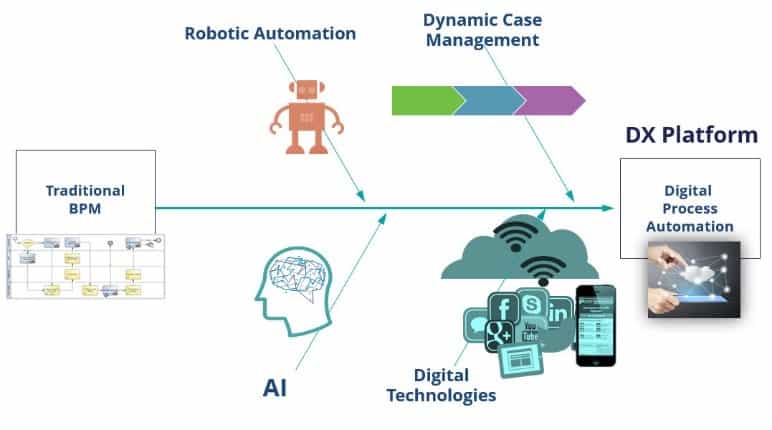
Digital Process Automation is the core enabler for Design Thinking Innovation. How innovative products work increasingly depends upon robust involvement of citizen developers with No-Code DPA as well as orchestration of value streams with people, applications, devices, and trading partners: all powered through DPA automation. DPA has evolved from traditional Business Process Management, incorporating and unifying Robotic Automation, Artificial Intelligence, Dynamic Case Management, and Digital Technologies. DPA is the core enabler for Digital Transformation.
Digital Process Automation – core enabler for Design Thinking Innovation
“Design is not just what it looks like and feels like.
Design is how it works.”
Steve Jobs
There are multiple areas of DPA innovation with Design Thinking for the Enterprise-In-Motion.
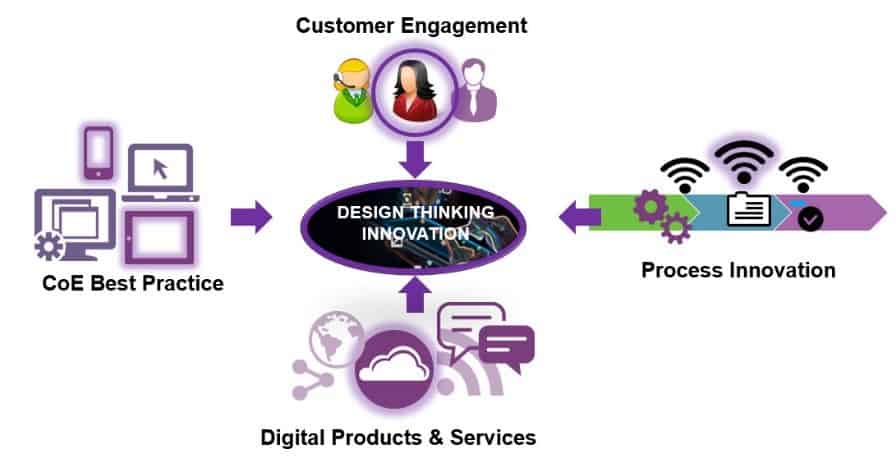
More specifically, the Enterprise-In-Motion can leverage DPA for innovation in four interrelated but distinct areas:
“design thinking is primarily an innovation process”
From: Design Thinking: Integrating Innovation, Customer Experience, and Brand Value

- Digital Innovation for Customer Engagement and Experience Optimization – with the Culture of 1:1 engagement and marketing. AI plays a huge role here in treating different customers differently through predictive and machine learning analytics. Data is the new crude oil, but the refineries that yield value are powered through AI. The 2-part article on Process+Data elucidated the power of end-to-end digitization of value streams through Digital Process Automation. More importantly, organizations will realize they need to shift the culture from bulk marketing, siloed organizations, and ad-hoc experiences to a digitally transformed 1:1 connected customer engagement. Connected Devices (IoT) will increasingly become customer engagement channels. In addition to AI and Dynamic Case Management (DCM) for connecting siloed organizations, technologies such as Robotic Process Automation (RPA), as well as Intelligent Virtual Assistants will emerge as key enablers.
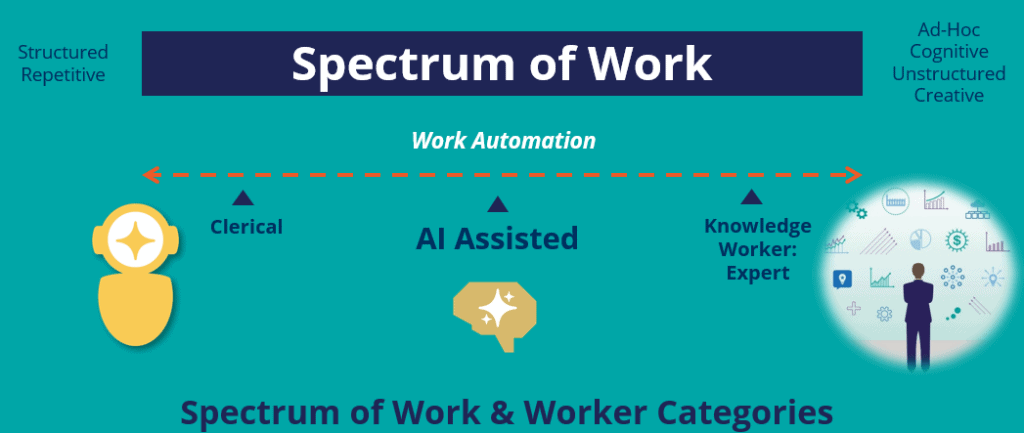
- Alleviating Silos through Process (Work) Automation: work automation enablers for digitizing value streams connecting customers, partners, and the entire ecosystem of organizations are all available through technologies such as Robotic Process Automation (RPA), Dynamic Case Management, IoT support, and Digital Process Automation. Connecting various siloes in the organizations will become critical. However, here again, the potential hindrances to connectivity are cultural. The past few years have seen a rekindling of value stream connectivity and comprehensive work automation strategies through Digital Transformation (DX) platforms that support RPA, DCM, IoT, and social interactions – all enabled through AI. The automated processes that provide end-to-end visibility from the customer as well as connected device (IoT) interactions all the way to back-end systems will become critical.
- New Product & Service Innovation: Digital technologies are moving extremely fast. The movement to the Cloud, Robotics, the Rise of Connected Things (IoT), and perhaps the most disruptive of them all: Blockchain – are some of the technologies that will shape (and potentially make or break) companies in next few years. The culture challenge here is that of speed in assimilating these technologies while at the same time – and even more importantly – prioritizing a culture of innovation for discovery and fast development of viable products or services. We have heard of “fail fast but succeed faster.” It is interesting to note that technologies such as Blockchain (that is the foundation of cryptocurrencies) actually have profound pragmatic implications. It will empower a new generation of innovators and disrupt potentially all industries.
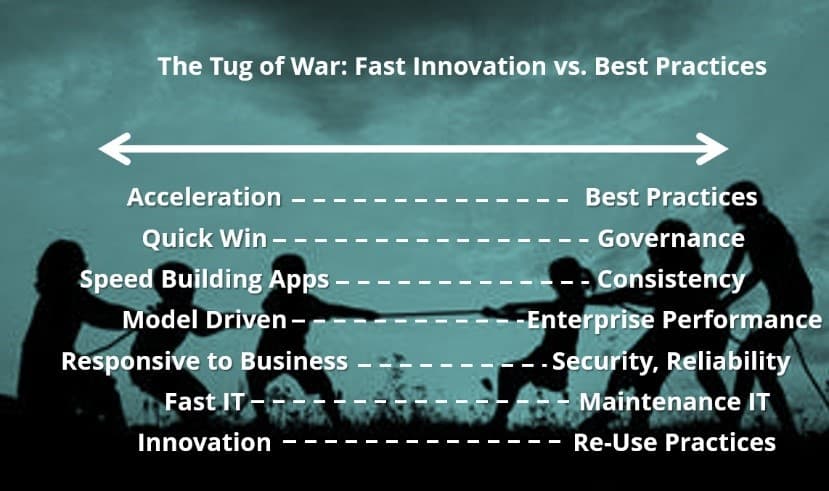
- DX CoE: Best Practices Culture will balance speed of innovation: As organizations try to leverage digitization they are often faced with a healthy tension between two compelling approaches: (1) Digital Innovation Speed: accelerated and streamlined digital application development for automation; (2) Digital Competency Best practices: enablement, methodologies, governance, and re-use to optimize delivery of work automation solutions. Organizations are realizing that they need to invest in and promote Digital Transformation Competency Centers (aka Center of Excellence (CoE)). Often organizations pursue the next digital technology “bright shiny object” without considering the competency perspective. They will no longer be able to afford that “luxury.” As organizations attempt to accelerate their work automation solutions across the Enterprise-In-Motion, it becomes even more critical to take a closer look at the core competency center (aka Center of Excellence (CoE)) strategies.
Design Thinking Methodology
The following illustrates the Design Thinking Methodology:
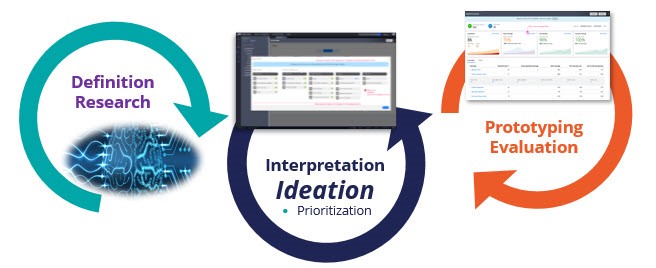
The Definition phase scopes the challenge of the organization with a clear statement that is achievable and measurable. This phase defines a clear focus of the challenge at hand. The Research phase uses techniques such as Personas, Interviews, and Observation to discover the needs and prioritize, especially as relevant to the most important focus of the innovation: Customers. The Interpretation phase uses empathy techniques to consider the emotions of the Customers. It also uses techniques such as the Fishbone Diagram to map the cause and effect. The Ideation is where the prioritized list of possible innovative solutions is generated. That is the focus of this post – especially with Digital Process Automation that as the backbone of innovation impacts all four areas of innovation. This is followed by Prototyping and Evaluation with specific implementations.
Prioritization
Prioritization is an essential milestone in Ideation. The Ideation techniques such as Brainstorming sessions that break into teams and come up with an initial prioritization. The Prioritization that subsequently identifies the low hanging fruit(s) for Prototyping and Evaluation progresses in two main milestones:
- DPA Prioritization Workshop
- Deeper Quantitative Assessment of Prototype Candidate

The workshop should include anywhere between 5 – 25 people. It is important to have representation from the business, customer experience, IT, digital technology, and operations side – depending upon the organization and its industry. Here is an outline of the 5 DPA Prioritization Workshop Phases:
- High-level Overview of the core Digital Process Automation innovation value propositions: this is critical. As illustrated above, there are four areas of Design Thinking innovation with DPA. Prior to the Brainstorming – or other idea generation techniques – the participants need to be educated on the DPA potential for innovation. Pragmatic case studies and examples of DPA innovation are also helpful.
- Agree on Criteria for Prioritization: The group discusses and ideates on the most important criteria for Prioritization. These criteria balance DPA problem fit, business value, and ease of implementation. The next phase will use these criteria during individual idea generation.
- Individual Ideation: Each member of the workshop comes up with several innovative ideas along the four areas – a guided “Brain Dump” with the criteria guiding their recommendations. It is important the workgroup members work independently in this phase – without external pressures.
- Group Discussion: If there are enough participants, the workshop members are broken into groups for group discussions. It is recommended each group have representation from the different personas. During this phase, the individual ideas are first discussed to see if there are affinities or similarities between the individual recommendations from the previous ideation phase. Typically, there will be clusters with several outliers. Next, the group will discuss and place the recommendations in four Prioritization groups:
– (i) Pursue – High Priority
– (ii) Support – Medium Priority
– (iii) Luxury – Medium Priority
– (iv) Avoid – Low Priority - Recommendations: In this phase, each group presents their Pursue priorities. There will be inter-group discussions and then a final vote on the candidate list of Pursue projects. It is also good to keep track of the other proposals: the backlog of prioritized DPA projects is dynamic and can change over time.
Therefore, Phase IV within each group is critical. The prioritization of various innovations can be placed in four buckets in a prioritization “canvas.” There are various criteria for the “X-axis” that represents the spectrum of Complexity-to-Ease and the “Y-axis” that represents the business value. There are quantitative measures that impact the “low hanging” innovation candidates.
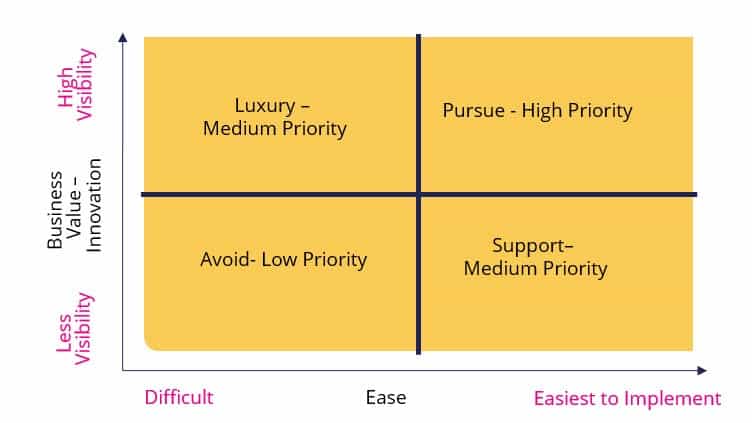
- Business Value How important is the innovation project to the business stakeholders? Some of the generic measures are increased revenue, operational excellence through controlling or decreasing cost, regulatory compliance, and risk mitigation.
- Ease and Complexity: Every DPA innovation project candidate will require integration with systems of record. Integrating with an old system that does not have a robust and modern API could be problematic. There are also other considerations, such as UX complexity, scalability, security, and privacy requirements.
The second milestone after the workshop takes the candidate backlog and goes deeper in agreed-upon criteria. This Prioritization Assessment includes more detailed evaluation of the Business Value and different aspects of ease of implementation and DPA problem fit. So, each project will obtain a score. Here is a sampling of scores for Business Value:

The details of this milestone are beyond the scope of this article. The Prioritization Assessment will result in a more precise ordering of the DPA Innovation Project Backlog:
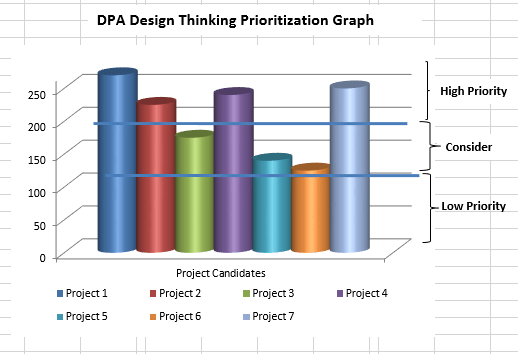
If you are interested in the details and would like to organize a DPA Prioritization Design Thinking Workshop, contact your Pega Account Executive, leave comments below, or send me a note ([email protected]). This is a proven qualitative and quantitative technique that will help you continuously Think Big with DPA for your Enterprise-In-Motion while Starting Small with innovative iterations.





